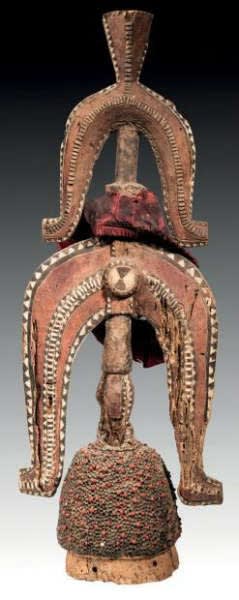
An interesting discovery in a small auctionin Paris, a Koro ngamdak headdress from Nigeria.
The Koro make these headdresses for themselves and for the Ham (Jaba), and probably also for the Kagoro, Kaje and Kamantam, as their religion and art are rather similar. The mask is the principal one, representing the ‘mother spirit’ of the tribe, in the dances held on the occasion of the spring sowing and the autumn harvest. An eyewitness account of the autumn celebration of 1949 at the Ham village of Nok (after which the ancient terracotta culture is named) follows.
The ceremonies began with some fearsome, faceless bush spirits to frighten and warm up the populace, then the warriors danced with long obsolete shields and the hunters mimed a hunt (including a man wearing the burtu hornbill headdress and crouching on all fours); finally, a troupe of dancers representing the able-bodied young men of the tribe with abstract headpieces danced vigorously around two tall figures, the mother spirits with turreted headdresses and dressed in great tent-like painted fibre growns. They would twirl around so that the gowns filled out majestically, and every few minutes would envelop one of the young men in a motherly embrace. Thus was the benevolence of the ancestors sought for the work of the year.
Source: William Fagg in Christie’s, London, 8 November 1977. Lot 218.

UPDATE: In the next Zemanek sale another type of Koro dance crest (labeled nyamfaik) can be found: lot 257.

(image courtesy of Zemanek)